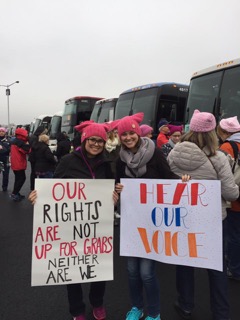
The Women’s March on Washington was Educational and Empowering
I was very fortunate to be able to attend the Women’s March on Washington on January 21 with a former student of mine, and the ability to share this momentous occasion with her was something neither of us will soon forget.
Lizette is a very special young woman. When she was a sophomore in high school, she approached me about starting an after-school group for young feminists. She needed a sponsor for the group, and I agreed. Even though she graduated in 2014, our group still meets, and we are growing every year. Needless to say, I was thrilled to share such a momentous occasion with a favorite young activist. We were even able to bring signs created by current members of the group, which allowed them to be involved, and created a powerful connection between the generations of feminist activists in our school.
The overnight bus rides there and back were brutal to say the least, but it was hard not to feel that we were part of a truly historical moment. Even though the cell towers were overloaded and we didn’t have the ability to check social media, we could tell that there were a lot more people there than anyone expected, and we could feel that energy. As Lizette noted: “Someday, I will be teaching a history lesson and this will come up in class and I’ll be able to say, ‘I was there!’”
While the positive energy was palpable, so was the white privilege. There were a lot of straight, white, cis, able-bodied women there who seemed to feel entitled to something just because they showed up, because someone had called them a hero for doing so, and you could see that entitlement oozing from them as they not-so-subtly elbowed their way through the tightly-packed crowds just so they could get a little bit closer, or as they loudly asked questions in response to speakers’ points such as, “How are we standing on Native Americans’ land? This is Washington D.C.!”
When we got back to the bus, Lizette noted that there weren’t as many women of color there as she would have liked to see, and we engaged in a discussion about white feminism and its sordid history. We both felt that the organizers did a great job creating the kind of intersectional space we would expect from a modern-day women’s rights rally, and as a Latina, she felt the speakers were inclusive and intersectional. However, we both noted that the crowd could learn a lot from listening to them.
She also mentioned that she learned a lot (and, as her former teacher, that was music to my ears). She saw one sign, in particular, that broke down the pay gap by men and women, and then by the race of the women, which was the first time she had seen the pay gap broken down in that way. What that taught me is that I need to do a better job of showing the young activists in our extra-curricular group statistics such as these that directly affect their lives.
All that said, though, the experience of attending the march – especially with a former student of mine – was awesome, in many ways. To see so many people put their “bodies where their beliefs are,” as Gloria Steinem said, was incredible. But it also hopefully opened a lot of people’s eyes to the awesome responsibility we have as citizens to not only show up, but to do the work. It was amazing to see Lizette, someone whom I have watched grow for years, have a fire lit under her. She and I both left the march having had an overwhelmingly positive experience even as we acknowledged that the movement had a long way to go, and we are already planning our next steps to participate in the resistance. The takeaway for both of us was this: Keep working. Keep showing up. Keep fighting. This is not the end.